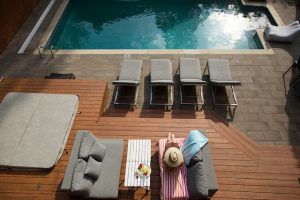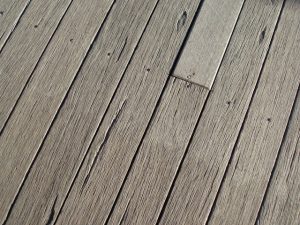
Do you know how heat and humidity affect your deck?
There is nothing more relaxing than being on your deck, enjoying the summer sun. Most homeowners would like to drift away for a nice nap as they sip a nice cool drink. However, the summer heat and humidity can cause distress for your deck. Without heat exposure and humidity can cause damage over time. You might be wondering what type of damage your deck can endure during the summer. Here is how heat and humidity could be damaging your deck!

Here you can see long-term damage that can be done by weather.
Here in the Midwest, we are used to crazy weather patterns that can change at the drop of a hat, but our decks? Not so much. Summer heat and humidity can really do a number on your deck, especially if your deck is untreated or unsealed. Composite decks have their own challenges as well.
We always recommend putting a protective layer on your deck, by staining or sealing it with a weather protective layer. This way your deck will have more longevity and be able to stand up to the elements. Or if you want you can negate the whole process by having a Trex Composite deck.
Damage can be done over time from heat, sun, and rain exposure. When it’s hot out wood will shrink and dry out, which makes it more absorbent to rain and liquids. This will absorb untreated wood and cause swelling and buckling. This cycle of shrinking and swelling will cause wood to warp and buckle and can pull nails out from joints.
To prevent this we recommend putting a sealant on your deck every 1-2 years for the best result. This will help keep wood exposed to the elements dry and will minimize the warping.
While having a composite deck has many benefits, there are a few humidity issues that it is susceptible to. One of these humidity issues is your deck’s surface becoming slick. Due to composite decks’ resistance to moisture, it is not absorbed. As a result, the moisture accumulates on the surface, making the deck slick. This problem also occurs with decks that are treated with sealant. That means that you need to be extra careful to avoid slipping and falling.
In the Midwest, our humidity levels can get overwhelming, and this can affect your deck. Mold and mildew spores are constantly in the air and normally aren’t too much of a problem. When rain and high humidity get into the mix, this creates the perfect conditions for them to grow in the nooks and crannies of your deck. When this growth happens you will typically see it as discolorations or stains on your deck. These stains generally look black, brown, or green and can spread and grow in the right conditions. This causes what is commonly referred to as mildew staining.
Once the stain has set into your deck you will have to either use a fungicide that is specially formulated for decks or use a 1:3 ratio Bleach to water solution (vinegar can also be substituted for the bleach if chemicals are a concern) to clean your deck. Follow this wash by sanding and sealing your deck after it has had a good week to dry out in the sun.
If your deck has seen better days or could use a touch up we can help. We work with clients who have decks that have been damaged by the wear and tear of these Midwest weather patterns. We’ll even give you a free estimate. Click here to get yours.